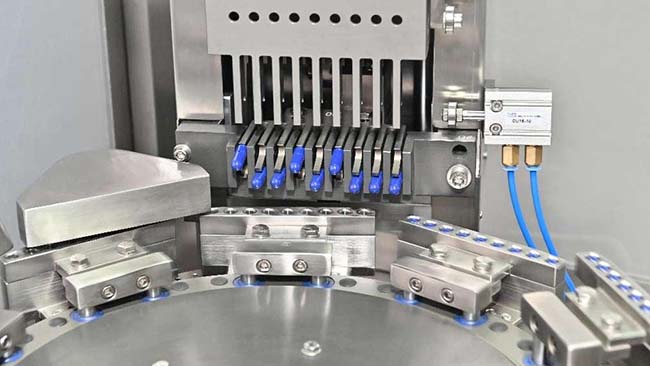آلة تعبئة الفقاعات آلة تعبئة وتغليف مهمة. يمكنها تعبئة الأقراص، والكبسولات، والحبوب، والحلوى، والسجائر الإلكترونية، والكبسولات اللينة، وحبوب العسل الكبيرة... كما يمكنها تعبئة السوائل مثل الكاتشب، والشوكولاتة، والعسل، والعطور، وغيرها. إنها آلة ثنائية الاستخدام مصنوعة من الألومنيوم والبولي فينيل كلوريد، والألومنيوم والألومنيوم. تعمل بنظام سيرفو كامل، ويمكن ضبط كل محطة بواسطة عجلة يدوية، وهي مريحة وسريعة، ويتم التحكم فيها بواسطة برنامج قابل للبرمجة بواسطة PLC.
مبدأ عمل آلة تعبئة الفقاعات

تُعد آلات التغليف بالنفط أساسية في صناعة التعبئة والتغليف، إذ توفر طريقة آمنة وفعّالة لتغليف مختلف المنتجات. يتضمن مبدأ عمل آلة التغليف بالنفط عدة عمليات رئيسية: التشكيل، والتغذية، والختم، والقطع. يُعد فهم كل من هذه العمليات أمرًا بالغ الأهمية لتحسين تشغيل الآلة وصيانتها. سنتناول هنا مبدأ عمل آلات التغليف بالنفط بالتفصيل.
1. محطة التشكيل
الخطوة الأولى في عملية التغليف بالبثور هي تشكيل تجاويف البثور التي ستحمل المنتجات. يمكن تنفيذ هذه الخطوة إما بالتشكيل الحراري أو التشكيل البارد. عادةً، تُشكَّل بثور الألومنيوم والبولي فينيل كلوريد (alu-pvc) بالتشكيل الساخن، بينما تُشكَّل بثور الألومنيوم والألومنيوم بالتشكيل البارد.
التشكيل الحراري: في هذه العملية، يُدخل غشاء بلاستيكي (عادةً ما يكون من PVC أو PVDC أو PET) إلى الآلة ويُسخّن حتى يصبح مرنًا. يُشكّل الغشاء المسخّن بعد ذلك بالشكل المطلوب للتجويف باستخدام قالب تشكيل. يضغط القالب الغشاء المسخّن داخل القالب، مما يُشكّل تجاويف الفقاعات.
التشكيل البارد: يُستخدم التشكيل البارد للمنتجات التي تتطلب خصائص عزل أفضل. في هذه الطريقة، تُدخل رقاقة من رقائق الألومنيوم إلى الآلة وتُضغط في قالب باستخدام قالب تشكيل. لا تتضمن هذه العملية تسخينًا، وتُستخدم عادةً للمنتجات الحساسة للرطوبة والأكسجين.
2. محطة التغذية
بعد تكوّن الفقاعات، تأتي الخطوة التالية وهي ملء هذه الفقاعات بالمنتج. عادةً ما يتم ذلك عبر نظام تغذية آلي يضع المنتج بدقة في كل فقاعة. يجب أن تكون عملية التعبئة دقيقة لضمان ملاءمة كل منتج لبثاقه الخاص دون أي انسكاب أو خلل.
يمكن اختيار طريقة التغذية وفقًا لخصائص المادة. يمكن استخدام مغذيات الفرشاة، ومغذيات التوجيه، ومغذيات خاصة.
تُستخدم وحدات التغذية بالفرشاة عادةً في عبوات الألومنيوم والبلاستيك، ولا تُلحق الفرشاة الضرر بالمادة. تُستخدم الفرشاة لوضع الأقراص أو الكبسولات في كل نفطة. تُعد طريقة التغذية هذه اقتصادية وعملية.
لماذا تُغلَّف بعض المواد بأغلفة من الألومنيوم والبلاستيك، وبعضها الآخر بأغلفة من الألومنيوم والألومنيوم؟ يُحدَّد ذلك بناءً على خصائص المنتج. يُستخدَم تغليف الألومنيوم والألومنيوم لبعض المواد التي يجب تخزينها بعيدًا عن الضوء.
تُستخدم مغذيات التوجيه عادةً في عبوات الألومنيوم. قد تُتلف طريقة التغذية بالفرشاة سطح رقائق الألومنيوم، بل وقد تخدشه. لذلك، تُختار مغذيات التوجيه لسرعة التغذية العالية.
هناك أيضًا مغذيات خاصة، وهي باهظة الثمن ولا ينصح بها إلا إذا كانت من خصائص المادة.
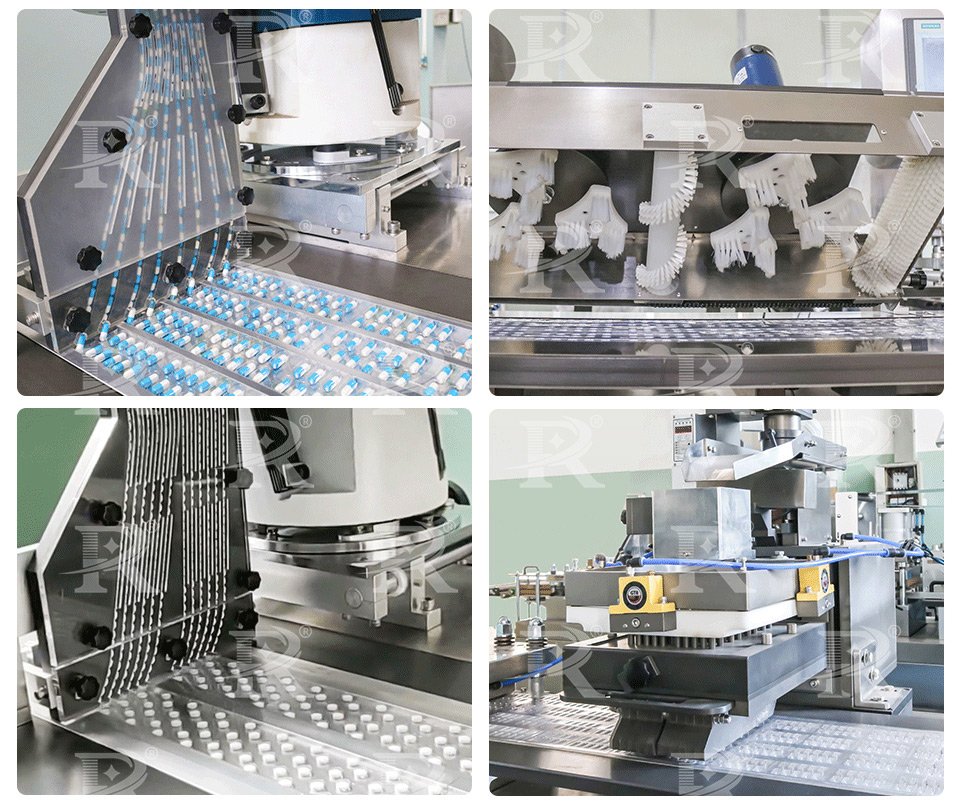
3. محطة العزل الحراري
بعد ملء البثور، تأتي الخطوة التالية وهي الختم الحراري. يُغلَق ورق الألمنيوم فوق البثور المملوءة ويُثبَّت. تتضمن عملية الختم عادةً الخطوات التالية:
التسخين: يتم تسخين رقائق الألومنيوم وحواف البثور البلاستيكية إلى درجة حرارة محددة.
تطبيق الضغط: يُطبّق قالب الختم ضغطًا لربط رقاقة الألومنيوم بالغشاء البلاستيكي، مما يُشكّل طبقةً محكمةً. هذا يضمن حماية المنتج من العوامل الخارجية كالرطوبة والضوء والهواء.
4. محطة القطع
الخطوة الأخيرة في عملية تعبئة البثور هي التقطيع. تُقطع البثور المغلقة إلى وحدات أو شرائح منفصلة. تتضمن هذه الخطوة:
التثقيب: إنشاء ثقوب بين عبوات البثور الفردية إذا كان من الضروري فصلها بسهولة.
قالب القطع: يقوم قالب القطع بتقطيع الورقة المختومة إلى الأشكال والأحجام المطلوبة، مما يؤدي إلى إنتاج عبوات نفطة نهائية جاهزة للتعبئة والتوزيع.
مبدأ عمل آلة التعبئة والتغليف بالنفط هو عملية منهجية تضمن تغليف المنتجات بشكل آمن وجذاب بصريًا ووقائيًا. بفهم تعقيدات التشكيل والتعبئة والختم والقطع، يمكن للمشغلين تحسين أداء الآلة، مما يضمن تغليفًا فعالًا وعالي الجودة بالنفط.
أنواع آلات التعبئة والتغليف
تُعدّ آلات التغليف بالنفط جزءًا لا يتجزأ من مختلف الصناعات، إذ تُوفّر حلول تغليف فعّالة وآمنة. تُلبّي أنواع مختلفة من آلات التغليف بالنفط احتياجات تغليف مُحدّدة، تبعًا لمتطلبات المنتج، وحجم الإنتاج، وخصائص المواد. سنناقش هنا الأنواع الرئيسية لآلات التغليف بالنفط:
1. آلات تعبئة الفقاعات ذات اللوحة المسطحة
آلات التغليف بالبثور ذات الألواح المسطحة هي نوع من معدات التغليف بالبثور، تتميز بتعدد استخداماتها، وتُستخدم على نطاق واسع في مختلف الصناعات، وخاصةً في الصناعات الدوائية والأغذية والسلع الاستهلاكية. تتميز هذه الآلات بدقتها وسهولة تشغيلها وملاءمتها للإنتاج على نطاق صغير ومتوسط.
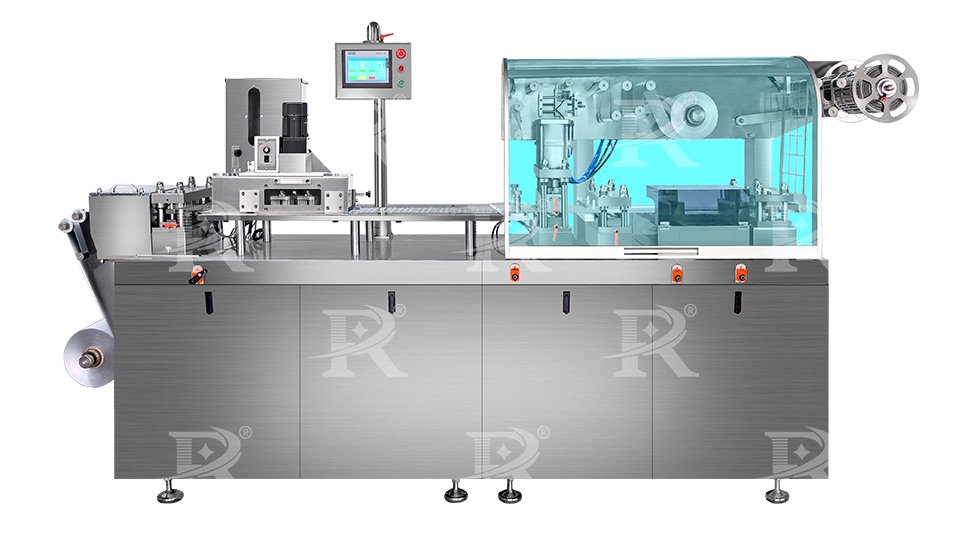
الميزات الرئيسية:
تشكيل وختم دقيق: يضمن تصميم اللوحة المسطحة تشكيل وختم دقيق ومتسق لعبوات البثور.
التنوع: مناسب لمجموعة واسعة من المنتجات، بما في ذلك الأدوية والمواد الغذائية والسلع الاستهلاكية الصغيرة.
سهولة التشغيل: عادةً ما تكون سهلة الاستخدام مع عناصر تحكم واضحة، مما يجعلها في متناول المشغلين بمستويات مختلفة من الخبرة.
التخصيص: يمكن تخصيصه للتعامل مع أحجام وتكوينات عبوات نفطة مختلفة.
تصميم مضغوط: غالبًا ما يكون أكثر إحكاما من الآلات الدوارة أو الأسطوانية، مما يجعلها مناسبة لبيئات الإنتاج الأصغر.
2. آلات التعبئة والتغليف بالبثور ذات الأسطوانة
صُممت آلات التعبئة والتغليف بالبثور ذات الأسطوانة لإنتاج مستمر وعالي السرعة. هذه الآلات مناسبة تمامًا لبيئات التصنيع واسعة النطاق حيث تكون الكفاءة والإنتاجية أمرًا بالغ الأهمية.
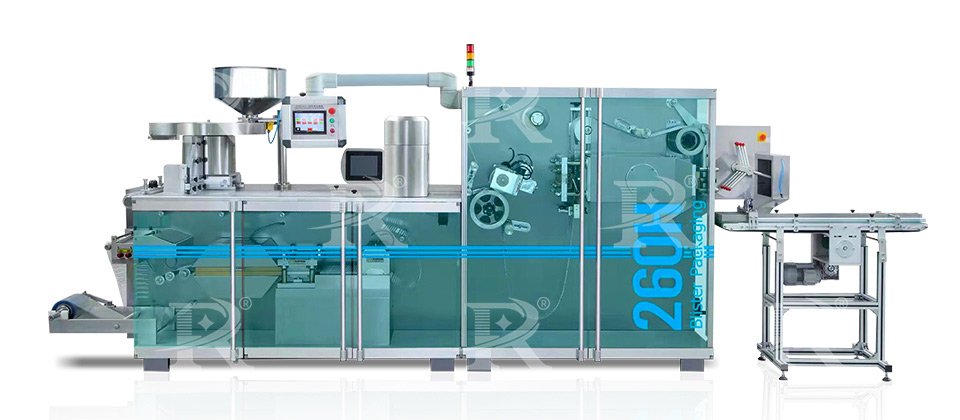
الميزات الرئيسية:
التغذية المستمرة: تستخدم لفات متواصلة من الفيلم البلاستيكي ومواد الختم.
تشغيل عالي السرعة: قادر على إنتاج كمية كبيرة من العبوات البلاستيكية في الدقيقة.
الدقة: تضمن تشكيلًا دقيقًا وملءًا وختمًا بسرعات عالية.
التطبيقات: تستخدم عادة في إنتاج الأدوية والسلع الاستهلاكية على نطاق واسع.
3. آلة تعبئة السوائل في نفطة
آلات تعبئة السوائل بالبثور هي معدات متخصصة مصممة لتعبئة المنتجات السائلة أو شبه السائلة في عبوات نفطة. توفر هذه الآلات حلاً آمنًا وسهل الاستخدام، مقاومًا للعبث، ومثاليًا لمجموعة من الصناعات، بما في ذلك الأدوية والأغذية ومستحضرات التجميل والمواد الكيميائية. يتعمق هذا الدليل في مبدأ عمل وميزات وتطبيقات آلات تعبئة السوائل بالنفط.
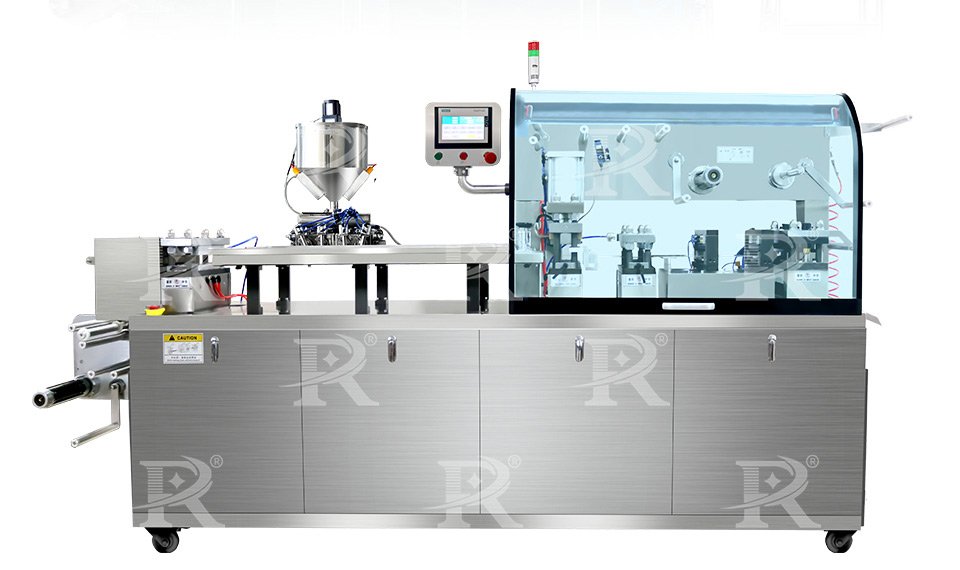
الميزات الرئيسية:
التعبئة الدقيقة: تضمن أنظمة الجرعات المتقدمة التعبئة الدقيقة لكل تجويف نفطة، وهو أمر ضروري للمنتجات السائلة.
الإغلاق المحكم: يضمن إغلاق المنتج السائل بشكل آمن، مما يمنع التسرب والتلوث.
مواد تشكيل متعددة الاستخدامات: يمكنها التعامل مع مجموعة متنوعة من مواد التشكيل والتغطية المناسبة لأنواع مختلفة من المنتجات السائلة.
التشغيل الآلي: تتميز العديد من الآلات بعناصر تحكم آلية للتشغيل الفعال والمتسق، مما يقلل الحاجة إلى التدخل اليدوي.
تصميم صحي: مصنوع من مواد سهلة التنظيف والتعقيم، مما يضمن الالتزام بمعايير النظافة.
4. آلات تعبئة الفقاعات المخبرية
صُممت آلات التعبئة والتغليف المخبرية للاستخدام في الإنتاج على نطاق صغير أو في المختبرات. تتميز هذه الآلات بحجمها الصغير وسهولة تشغيلها وفعاليتها من حيث التكلفة، مما يجعلها مناسبة للدفعات الصغيرة والتعبئة والتغليف حسب الطلب.
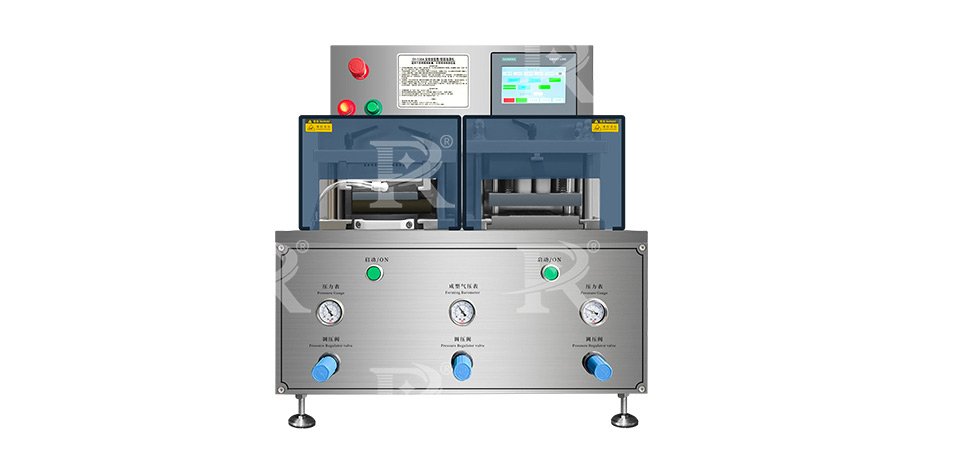
الميزات الرئيسية:
حجم صغير: حجم صغير، مناسب للبيئات ذات المساحة المحدودة.
التشغيل اليدوي أو شبه التلقائي: غالبًا ما يتضمن عمليات التحميل والختم اليدوية.
المرونة: مناسبة لتعبئة مجموعة واسعة من المنتجات الصغيرة.
التطبيقات: تستخدم في المختبرات والإنتاج على نطاق صغير والتعبئة والتغليف حسب الطلب.
يعتمد اختيار نوع آلة التعبئة والتغليف بالنفط على المتطلبات الخاصة بالمنتج، وحجم الإنتاج، وخصائص التغليف المطلوبة. سواءً للإنتاج عالي السرعة وواسع النطاق أو للتغليف المخصص بكميات صغيرة، تتوفر آلة تعبئة بالنفط مصممة خصيصًا لتلبية هذه الاحتياجات. إن فهم الاختلافات وإمكانيات كل نوع يضمن اختيار الآلة الأنسب لعمليات تعبئة وتغليف فعّالة.
تطبيقات آلات التعبئة والتغليف بالبثور
1.صناعة الأدوية
الأقراص والكبسولات: عبوات نفطة توفير طريقة آمنة وصحية لتعبئة الأقراص والكبسولات، وحمايتها من الرطوبة والضوء والتلوث.
الأغشية الرقيقة والمساحيق الفموية: تُستخدم عبوات نفطة متخصصة للأغشية القابلة للذوبان والأدوية المسحوقة.
تعبئة الجرعة الواحدة: تضمن الجرعات الدقيقة والتعبئة المقاومة للتلاعب للجرعات الفردية، مما يحسن التزام المريض وسلامته.
2. صناعة الأغذية والمشروبات
التوابل والصلصات: تعتبر العبوات البلاستيكية مثالية لتقديم كميات فردية من التوابل مثل الكاتشب والخردل وصلصات السلطة.
الوجبات الخفيفة والحلويات: تغليف الحلوى الصغيرة، والعلكة، وقطع الشوكولاتة.
الأطعمة السائلة: تغليف الأطعمة السائلة مثل العسل والشراب والمكملات الغذائية في عبوات للاستخدام مرة واحدة.
3. الأجهزة الطبية
الحقن والإبر: تغليف معقم وآمن للأجهزة الطبية التي تستخدم مرة واحدة.
مجموعات التشخيص: عبوات نفطة لشرائط الاختبار والمكونات الأخرى لمجموعات التشخيص.
الأدوات الجراحية: تغليف الأدوات والآلات الجراحية الصغيرة.
4. صناعة مستحضرات التجميل
الكريمات والمواد الهلامية: عبوات للاستخدام مرة واحدة للكريمات والمواد الهلامية والمستحضرات.
عينات المكياج والعطور: عبوات بلاستيكية لعينات المنتجات مثل العطور والأساس ومستحضرات التجميل الأخرى.
تؤدي آلات التغليف بالبثور دورًا محوريًا في مختلف الصناعات، من خلال توفير حلول تغليف آمنة وفعالة ومريحة. قدرتها على حماية المنتجات، وضمان دقة الجرعات، وتعزيز راحة المستهلك، تجعلها لا غنى عنها في الصناعات الدوائية، والغذائية، والسلع الاستهلاكية، والطبية، ومستحضرات التجميل، والكيميائية. باختيار آلة التغليف بالبثور المناسبة، يمكن للشركات تحسين سلامة المنتجات، ومدة صلاحيتها، وتجربة المستخدم بشكل ملحوظ، مما يعزز كفاءتها التشغيلية وقدرتها التنافسية في السوق.

